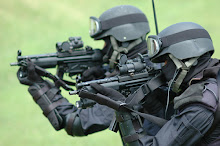
While missiles and RPGs have downed more helicopters in both Iraq and Afghanistan, insurgents shouldering the venerable AK-47 are a far more frequently encountered threat to helicopters in Afghanistan than shoulder fired missiles.
Army and Marine helicopters have been equipped with electronic detection and countermeasures to protect against shoulder fired and larger missiles for years. Yet, there are no systems to tell pilots when they’re coming under small arms fire. That’s about to change.
The military is sending four UH-60 Blackhawk helicopters to Afghanistan, each of which is rigged with 18 acoustical sensors able to detect the supersonic shock wave of a bullet in flight and then triangulate and pinpoint the gunmen. The program, known as Helicopter Alert and Threat Termination (HALTT) system, under development by DARPA, will see its first operational testing come October, Zachary Lemnios, director of Defense Research & Engineering, told reporters today.
HALTT borrows technology from the Boomerang acoustic gunshot detection system developed for ground vehicles. The helicopter equivalent is intended to warn pilots of where the shooter is located, in under a second, so they can either take evasive action or engage.
According to data compiled by a congressionally mandated study (see article pg. 9) on helicopter survivability, a total of 70 U.S. helicopters have been downed by hostile fire in Iraq and Afghanistan from 2001 through 2009. The report found that 375 helicopters in total have been lost; 305 of those classified as non-hostile and non-combat events. The study found that insurgents most often visually acquired their targets as 75 percent of helicopters were downed during daylight hours; the report does not say whether infra-red tracking missiles accounted for any night-time losses.
Small arms fire, including machine guns, have accounted for 31 percent of helicopter losses in Iraq and Afghanistan; the majority of losses came from enemy RPGs and MANPADS. The low loss rate to small arms fire actually represents a huge improvement over Vietnam, where some 2,000 helicopters were downed by enemy fire; 94 percent of those losses coming from small arms fire.
The study concluded that better tactics, flying at night with the aid of night vision and hardier aircraft design in today’s wars account for the dramatic difference. In the early Vietnam years, single engine designs, lack of night vision goggles, lack of critical system redundancy and non-crashworthy fuel systems resulted in high losses.
The study says there were no reported losses in Iraq or Afghanistan to radar-guided weapons.
( www.defensetech.org )
Army and Marine helicopters have been equipped with electronic detection and countermeasures to protect against shoulder fired and larger missiles for years. Yet, there are no systems to tell pilots when they’re coming under small arms fire. That’s about to change.
The military is sending four UH-60 Blackhawk helicopters to Afghanistan, each of which is rigged with 18 acoustical sensors able to detect the supersonic shock wave of a bullet in flight and then triangulate and pinpoint the gunmen. The program, known as Helicopter Alert and Threat Termination (HALTT) system, under development by DARPA, will see its first operational testing come October, Zachary Lemnios, director of Defense Research & Engineering, told reporters today.
HALTT borrows technology from the Boomerang acoustic gunshot detection system developed for ground vehicles. The helicopter equivalent is intended to warn pilots of where the shooter is located, in under a second, so they can either take evasive action or engage.
According to data compiled by a congressionally mandated study (see article pg. 9) on helicopter survivability, a total of 70 U.S. helicopters have been downed by hostile fire in Iraq and Afghanistan from 2001 through 2009. The report found that 375 helicopters in total have been lost; 305 of those classified as non-hostile and non-combat events. The study found that insurgents most often visually acquired their targets as 75 percent of helicopters were downed during daylight hours; the report does not say whether infra-red tracking missiles accounted for any night-time losses.
Small arms fire, including machine guns, have accounted for 31 percent of helicopter losses in Iraq and Afghanistan; the majority of losses came from enemy RPGs and MANPADS. The low loss rate to small arms fire actually represents a huge improvement over Vietnam, where some 2,000 helicopters were downed by enemy fire; 94 percent of those losses coming from small arms fire.
The study concluded that better tactics, flying at night with the aid of night vision and hardier aircraft design in today’s wars account for the dramatic difference. In the early Vietnam years, single engine designs, lack of night vision goggles, lack of critical system redundancy and non-crashworthy fuel systems resulted in high losses.
The study says there were no reported losses in Iraq or Afghanistan to radar-guided weapons.
( www.defensetech.org )



No comments:
Post a Comment